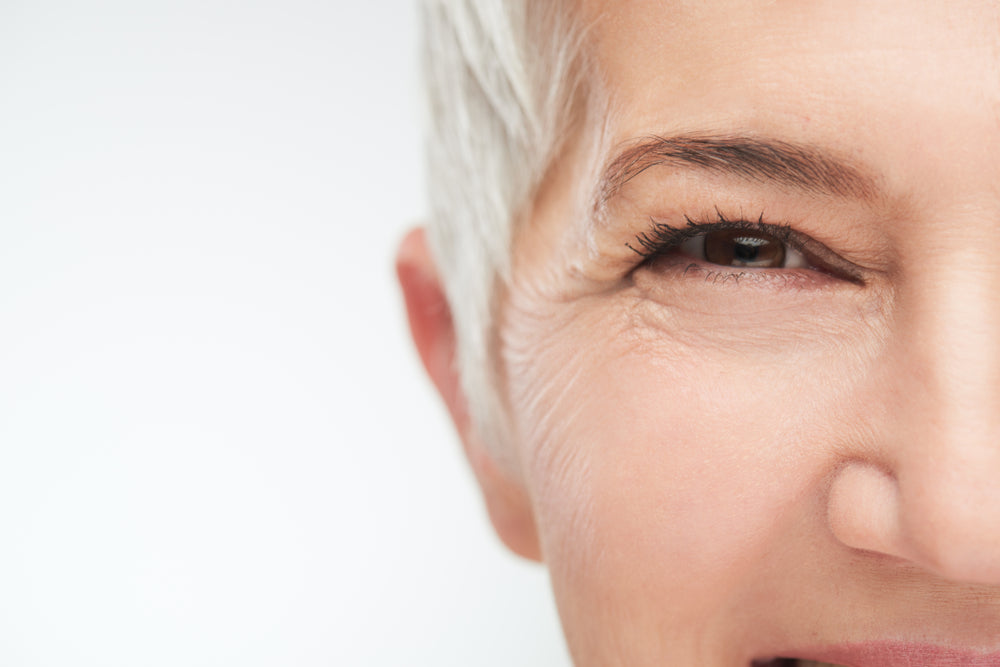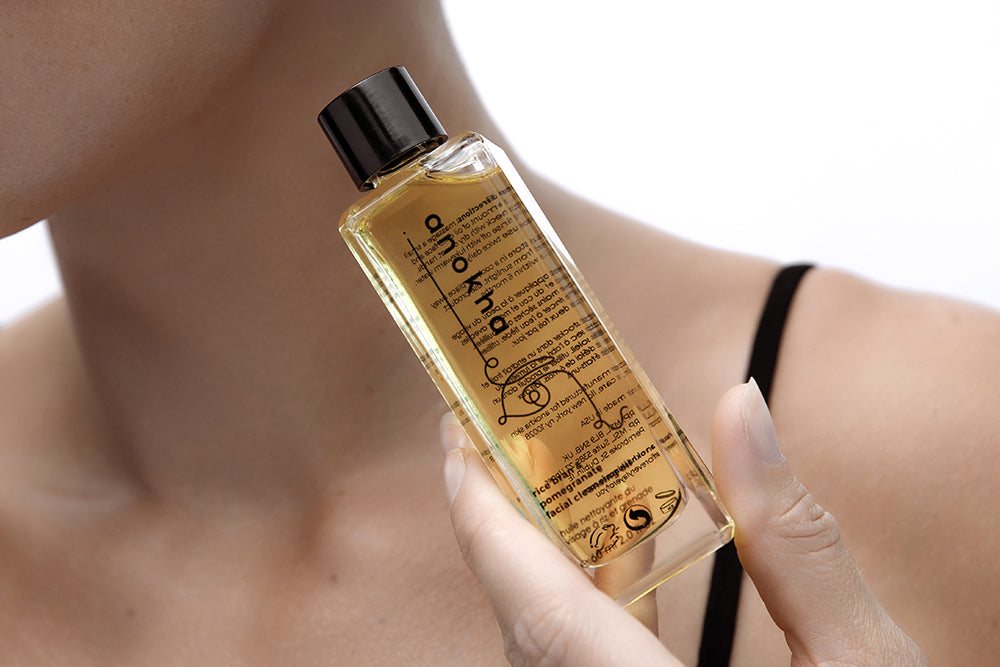
skincare for menopause

the bottom line
Let’s face it – aging isn't for the faint of heart. Menopause is marked by a number of changes in a woman’s body. While most attention is understandably devoted to the more dramatic vasomotor symptoms of weight gain, night sweats, and hot flashes, our skin will also reflect hormonal changes. Given the number of changes that our skin will experience, it’s helpful to know how we can address them to mitigate some of the effects.
first layer: the pause
We call it “menopause”, but it’s a lot more than a benign pause. Menopause represents a permanent estrogen-deficient condition in which skin health is dramatically affected. The changes include a loss of collagen*, elastin*, vascularity*, fibroblast* function, and an increase in matrix metalloproteinase* (MMP) activity. The result is a degradation of cellular and extracellular function which creates dryness, wrinkling, atrophy*, impaired wound healing, a diminished skin barrier*, and decreased antioxidants*.
second layer: the science of menopause
The skin is considered to be a peripheral endocrine* organ, and there are three key hormones which can significantly affect the skin: estrogen, progesterone, and testosterone. Estrogen helps to stimulate the production of elastin, collagen, and hyaluronic acid*. Progesterone affects the production of sebum, while testosterone activates the sebaceous glands to produce oil. Specific hormonal changes during perimenopause and menopause include:
- estrogen deficiency: Skin estrogen synthesis occurs in keratinocytes*, melanocytes*, and fibroblasts. Estrogen also induces ezrin, a structural protein that supports the epidermis, induces the hyaluron to boost skin thickness and opacity, and induces the expression of collagen and elastin. Estrogen deficiency therefore manifests as impaired skin barrier function with skin dryness and decreased sebum production; decreased antioxidant function and impaired wound healing; decreased synthesis of collagen and elastin with wrinkles and thinning of the dermis; decreased hyaluronic acid with reduced hydration and skin turgor; and thermoregulation dysfunction with pallor, reduced vascularity, and hot flashes from vasodilation* within the dermis.
- androgen* levels decrease: androgen secretion declines gradually, but is relatively higher than estrogen and progesterone, and therefore manifests as clinical hyperandrogenism. The result is a relative increase in androgens during this period, with sebaceous gland hypertrophy that may manifest as benign lumps under the skin. Later in menopause, sebum production is markedly reduced, and the skin becomes dry and itchy with eventual sagging and atrophy.
- higher cortisol levels: higher cortisol levels in the late perimenopause period can contribute to dryness, inflammation, and wrinkling. Stress hormones including cortisol negatively affect the epidermal barrier.
In summary, some of the most remarkable changes in skin noted with menopause include the following:
general changes:
- increased dryness and itching
- increased number of wrinkles
- thinning and atrophy of the skin
- impaired wound healing
- decreased skin barrier function
- decreased antioxidant capacity with a decrease in defense against oxidative stress
epidermal changes:
- increase melanocyte activity
- decreased re-epithelialization*
- increased number of pores
- flattening of the epidermal-dermal junction
dermal changes:
- decreased hydration
- decreased synthesis of collagen
- decreased elastic fibers
- decreased fibroblast function
- increase in MMP’s
- decreased vascularity
subcutaneous fat* changes:
- decreased volume and distribution of subcutaneous fat
Bear in mind that sun exposure, pollution, and other lifestyle factors will also affect how skin ages in addition to the changes initiated by menopause.
third layer: skin care during menopause
While hormone replacement therapy may alleviate some of the skin symptoms of menopause, it is not indicated for these changes alone. Phytoestrogens* have been proposed for the treatment of aging and estrogen-deficient skin. 12-24 week clinical studies with phytoestrogens and isoflavones* versus an isoflavone alone have shown an improvement in skin dryness, thickness, facial wrinkles, fibroblast viability, increased hyaluronic acid levels, and collagen production.
For most women going through menopause, focusing on the primary symptoms in the skin may provide the best relief as opposed to beginning an entirely new skin regimen. For skin dryness, intense hydration and protection of the skin barrier, can be extremely helpful during both the perimenopausal and menopausal periods. One star ingredient for menopause is Centella asiatica, or gotu kola, which has anti-inflammatory, antioxidant, wound healing, and collagen-stimulating properties. Another excellent ingredient at this time is hyaluronic acid which assists in hydration and plumping of the skin. For episodes with excess sebum and oil production, gentle exfoliation and mildly acidic toners will help to decrease excess oil. Finally, don’t forget your sunscreen to help decrease photoaging secondary to ultraviolet (UV) exposure.
fourth layer: how we do it
For perimenopausal and menopausal skin, we recommend a gentle regimen to optimize hydration and which includes our oatmeal cleansing milk, lotus flower & rosewater toner, lotus & lychee facial crème, and bakuchiol & pomegranate facial oil. For periods of androgen excess marked by skin oiliness and breakouts, our anokha man capsule collection is helpful in reducing excess sebum and aiding exfoliation.
All this and more at www.anokhaskincare.com .
xx
anokha
references:
- Zouboulis CC, Blume-Peytavi U, Kosmadaki M, et al. Skin, hair and beyond: the impact of menopause. Climacteric 2022; 25(5): 434-442.
- Brincat MP, Baron YM, Galea R. Estrogens and the skin. Climacteric 2005; 8(2): 110-123.
- Lephart ED, Naftolin F. Menopause and the skin: old favorites and new innovations in cosmeceuticals for estrogen-deficient skin. Dermatol Ther 2021; 11: 53-69.
- Owen CM, Pal L, Mumford SL, et al. Effects of hormones on skin wrinkles and rigidity vary by race/ethnicity: four-year follow-up from the ancillary skin study of the Kronos Early Estrogen Prevention Study. Fertil Steril 2016;106: 1170-1175.
- Rzpecki AK, Murase JE, Juran R, Fabi SG, McLellan BN. Estrogen-deficient skin : the role of topical therapy. Int J Womens Dermatol 2019; 5: 85-90.
- https://us.ishga.com/blogs/news/what-3-hormones-can-affect-our-skin-health
definitions:
androgens: androgens are a group of sex hormones. testosterone is the most common androgen.
antioxidant: an antioxidant is a compound that inhibits oxidation. free radicals create oxidative stress and an inflammatory response which in turn can damage DNA and result in injury to the epidermal and dermal layers of the skin. in the skin, this manifests as premature aging with decreased elasticity leading to increased wrinkling, age spots, and decreased skin tone. antioxidants stabilize free radicals, which in turn limits their ability to damage the body.
atrophy: wasting away of tissues
collagen: a fibrous protein that forms part of the dermal matrix, connective tissue, cartilage, and bone
dermis: the dermis is the layer of tissue beneath the epidermis which contains blood vessels, nerve endings, sweat glands, and hair follicles.
elastin: elastin is a protein that forms the main component of elastic fibers in the skin. it provides stretch, recoil, and elasticity.
endocrine: the endocrine system is a system of glands and organs which uses hormones to control and coordinate the body’s metabolism, reproduction, development, and response to stress.
epidermis: the outer layer of the skin overlying the dermis
fibroblast: a fibroblast is a cell that contributes to the formation of connective tissue within the body. fibroblasts secrete collagen proteins which help to maintain the structural framework of the tissues.
hyaluronic acid: hyaluronic acid plays an important role in the human body and is involved in hydration and joint lubrication. its synthesis increases during tissue injury and wound healing, and it regulates specific aspects of tissue repair.
isoflavone: plant-based compounds that mimic the action of estrogen
keratinocyte: the primary cell of the epidermis, which constitutes 90% of epidermal skin cells. keratinocytes form a barrier against environmental damage and are shed every 45-60 days.
matrix metalloproteinase (MMP) : matrix metalloproteinases are a member of a group of enzymes that can break proteins such as collagen or elastin. they can be over-stimulated by internal or external agents to break down healthy proteins.
melanocyte : pigment-producing cells located in the basal layer of the epidermis
phytoestrogens : phytoestrogens are estrogen-like compounds derived from plants. four phenolic compounds which are classified as phytoestrogens include isoflavones, stilbene, coumestan, and lignan.
re-epithelialization : the resurfacing of a wound with new epithelium
skin barrier: the skin barrier protects against external agents including mechanical and chemical insults, heat, pathogens, water, and radiation.
subcutaneous fat : fat located in the deepest layer of the skin
vascularity: refers to the degree of blood vessels which provide oxygen and nutrients to cells
vasodilation: widening of blood vessels, which increases blood flow
faq’s:
what is menopause?
menopause represents a permanent estrogen-deficient condition in which skin health is dramatically affected.
what skin changes are seen during menopause?
skin changes include a loss of collagen, elastin, vascularity, fibroblast function, and an increase in matrix metalloproteinase activity. the result is a degradation of cellular and extracellular function which creates dryness, wrinkling, skin atrophy, impaired wound healing, a diminished skin barrier, and decreased antioxidants.
how should I care for my skin during menopause?
for most women going through menopause, focusing on the primary symptoms in the skin may provide the best relief as opposed to beginning an entirely new skin regimen. for skin dryness, intense hydration and protection of the skin barrier are helpful during both the perimenopausal and menopausal periods.



Hinterlasse einen Kommentar
Diese Website ist durch hCaptcha geschützt und es gelten die allgemeinen Geschäftsbedingungen und Datenschutzbestimmungen von hCaptcha.